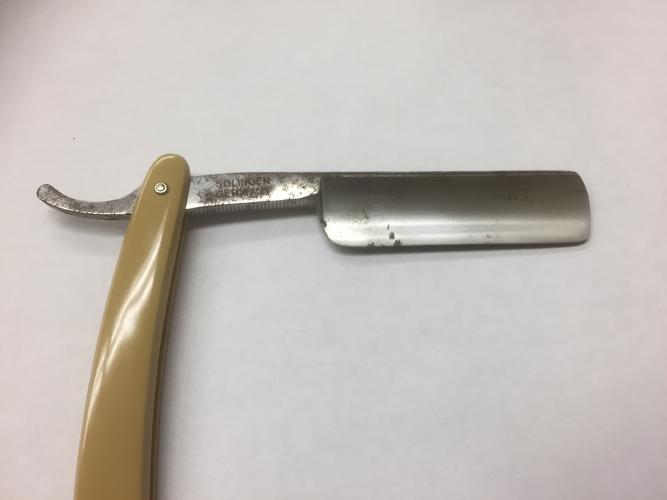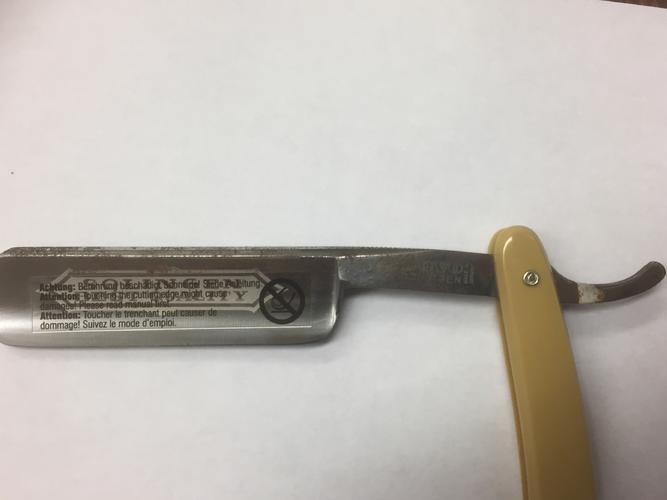Results 1 to 10 of 15
Thread: Rusted unused Dovo
-
06-19-2018, 07:08 PM #1Senior Member

- Join Date
- May 2016
- Location
- Magog, Quebec
- Posts
- 560
Thanked: 81 Rusted unused Dovo
Rusted unused Dovo
I rescued this poor razor today. Apparently the guy's girlfriend (now ex) bought it for him in Italy a few years ago and he never used it. It wasn't stored well, so it went to rust.
As you can hopefully see, most of the rust is on the spine and tang. There's not too much on the face of the blade, but there's some along the edge. I'm hoping I can hone past it. I paid $20 for this razor, so even if it goes in the garbage eventually or turns into a 5/8 from a 6/8, it will be a good contender for a restoration attempt.


-
06-19-2018, 08:40 PM #2Senior Member

- Join Date
- Jul 2012
- Location
- Mooresville NC
- Posts
- 742
Thanked: 133
Could also turn it into a shorty as well, GL with the restore
-
06-19-2018, 09:32 PM #3

Id start with working on the edge to see how much your going to need to take off to get to good steel where the rust is. Maybe its not deep and can clean up easy. Be sure to use a loupe and inspect the rust pitting as you work the edge on the stone so as to not take more than needed. Ive had a few that took away a lot of steel and some that cleaned up quickly. Good luck and keep us posted.
It's just Sharpening, right?
Jerry...
-
06-19-2018, 10:11 PM #4Senior Member



- Join Date
- Mar 2012
- Location
- Thunder Bay, Ontario, Canada
- Posts
- 17,350
Thanked: 3228
I think you'll be OK. I'd just rough clean the rust near the edge and, like Gasman suggested, see what kind of edge you get.
BobLife is a terminal illness in the end
-
06-19-2018, 10:44 PM #5Senior Member


- Join Date
- Feb 2018
- Location
- Manotick, Ontario, Canada
- Posts
- 2,813
Thanked: 563
I often use a DE blade with tape on one edge to scrape of the surface rust before resorting to sanding. Then I go at it with MAAS or Autosol metal polish to see how much of what remains comes off easily. Automotive rubbing compound on a microfibre cloth can also remove the easier stuff. I have used toothpaste or a paste of baking sofa and water and a stiff toothbrush to get at the parts of the tang between the scales.
Whatever is left will require sanding. As stated above, start with the highest grit wet/dry you feel might work before resorting to the really abrasive stuff. Sometimes I find that a Scotch Brite pad can take off some of the rust before I move on to sandpaper.
I have used abrasive pads, brass brush and nylon brush with a Dremel, but you have to be careful not to let the spinning pad catch the edge - wear eye protection and be aware of the “safe zone” so you don't break the blade or send it flying. The Dremel spins very fast and it’s easy to make an error in positioning the blade.
I learned that there is no point setting a bevel and honing the edge until you get all the rust and corrosion off to your satisfaction. You’ll just have to go at the edge again when you are done.David
“Shared sorrow is lessened, shared joy is increased”
― Spider Robinson, Callahan's Crosstime Saloon
-
06-19-2018, 11:28 PM #6Senior Member

- Join Date
- May 2016
- Location
- Magog, Quebec
- Posts
- 560
Thanked: 81
-
06-19-2018, 11:31 PM #7Senior Member

- Join Date
- May 2016
- Location
- Magog, Quebec
- Posts
- 560
Thanked: 81
-
06-20-2018, 12:37 AM #8

Good advice so far . For small rust spots a toothpick or wooden chopstick dipped in metal polish can be a a good starting point also.
The white gleam of swords, not the black ink of books, clears doubts and uncertainties and bleak outlooks.
-
The Following User Says Thank You to onimaru55 For This Useful Post:
DoughBoy68 (06-20-2018)
-
06-20-2018, 03:32 AM #9

Will add this tip to my knowledge base........Thanks!
A tip I picked up a couple of years back was moisten crumpled up tin/aluminum foil, it will help remove the rust due to a chemical reaction plus its softer than metal so it won't damage the blade. Be careful working around the edge so you don't get cut, we don't need another "Cut Of The Day" post!Last edited by DoughBoy68; 06-20-2018 at 03:38 AM.
"If You Knew Half of What I Forgot You Would Be An Idiot" - by DoughBoy68
-
The Following User Says Thank You to DoughBoy68 For This Useful Post:
joelkerr (06-20-2018)
-
06-20-2018, 11:56 AM #10Senior Member

- Join Date
- Sep 2017
- Location
- Upstate New York
- Posts
- 641
Thanked: 104
Good call on no dremel tool. Little wheel slips off and the spinning shaft hits the blade edge and chips it. I love how we are all rust removal experts! Copper sheets, hard pencils, 000 steel wool, and more types of sandpaper than I ever knew existed. Good luck with what looks like a pretty good razor.


 48Likes
48Likes LinkBack URL
LinkBack URL About LinkBacks
About LinkBacks






 Reply With Quote
Reply With Quote


